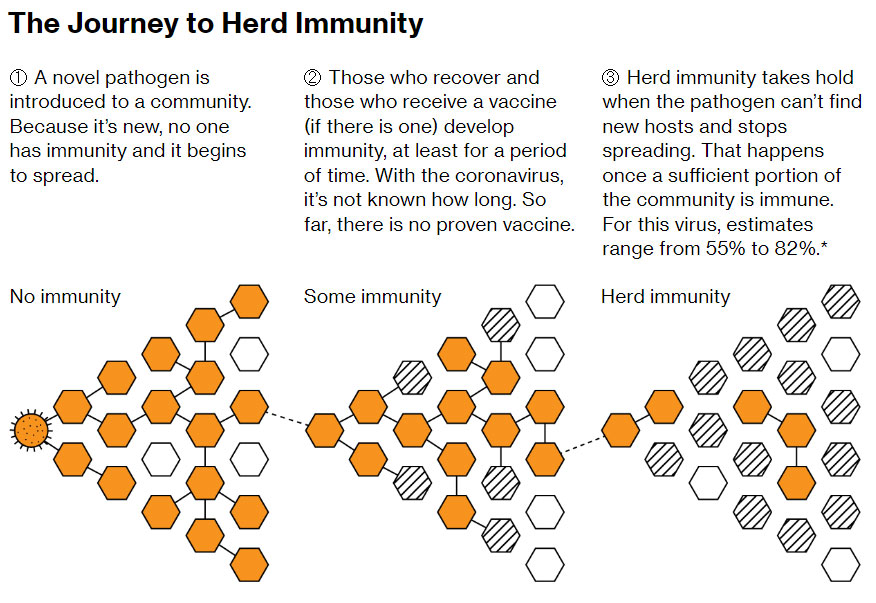Friday Notes: CDC data update, herd immunity, and surge in COVID-19 testing
Posted on April 24, 2020
A week ago I wrote a brief analysis of CDC and NY data that confirmed a low risk of death for healthy people, especially under the age of 65, using known case and death statistics. I’ve updated the data using this week’s NY and CDC data. Click on the link above for a full explanation.
This week’s numbers remained largely the same. The only minor changes were a 1% shift in the % of total cases from the 45-64 year-old age group to the 65-74 year old age group, and a 2% shift in the % of total deaths from the 45-64 age group to the 75+ age group. The result is that the 45-64 age group saw a small increase baseline survivability rate while the 75+ age group saw a 1% decrease in baseline survivability. When we factor out comorbidities, the adjusted survival rate for this week looks like this:
| Age | Deaths (Healthy Individuals) | Survivability Rate (Healthy Individuals) |
|---|---|---|
| 0-44 Years | 158 | 99.95% |
| 45–64 years | 900 | 99.72% |
| 65–74 years | 1200 | 98.82% |
| 75+ years | 3144 | 97.11% |
At the end of my previous post on CDC data, I included a note about a Stanford study which concluded that in one county in California, the number of infected people was 50-85 times higher than reported, based on local COVID-19 antibody testing.
Since then, other studies have been conducted around the country that have, at a minimum, confirmed that the number of cases is many-fold higher than reported.
- A Los Angeles county antibody study concluded that the number of cases could be 28-55 times higher than reported.[1]
- A Massachusetts General Hospital study showed that 32% of the test group tested positive for COVID-19 antibodies.[1]
- A New York City antibody study showed that nearly 22% of people in the study tested positive for COVID-19 antibodies.[1]
What this means is that the true survivability rate for all age groups is much higher than what the reported numbers show. What this doesn’t mean is that people should be throwing caution into the wind. People in the 75+ age group and people with serious underlying health conditions still need to be vigilant about social distancing until reliable therapeutics are developed and approved by the FDA. But it does give us hope that life can start getting back to normal for many people in the country.
Beginnings of Herd Immunity?
Recent research has estimated that nearly 70% of people in the US will need to have COVID-19 antibodies for the spread of COVID-19 to stop completely. Here’s a look at how herd immunity develops in a population without a vaccine (courtesy Bloomberg News):

If it’s true that 20-33% of the population already has COVID-19 antibodies, that means that some intermediate level of herd immunity is already taking place around the country. What this means is that for some period of time, the growth of COVID-19 is going to naturally slow, as there are less and less people who can contract the virus and spread it to others.
Without a vaccine (and no real promise of one ever), we may need to adjust our expectations, from achieving full herd immunity through vaccination to learning how to thrive in this intermediate stage of immunity, at least until effective therapies emerge. As federal, state, and local leaders begin to make their plans to reopen, they should take this data into consideration to make the wisest choices for their constituents.
A new trend in testing emerging?
Yesterday we saw a huge uptick in the number of reported tests. For the last couple weeks, we had been in the range of 130K-170K tests/day nationwide. Yesterday we recorded 373K tests, over double the average. Today, we’ve already logged 79K new tests. This is good news, as more testing means a better picture of how many mild and asymptomatic cases are out there.
What’s very interesting about yesterday’s numbers is that the percentage of positive tests yesterday was only 8.51%. This runs counter to what we’ve been hearing for the last several weeks. We would expect that more testing would lead to a higher percentage of confirmed cases.
Could this be confirmation that some level of herd immunity is really taking place and the number of current asymptomatic cases is actually much lower than expected because many of the mild and asymptomatic cases have already recovered? We certainly hope so, but only time will tell.